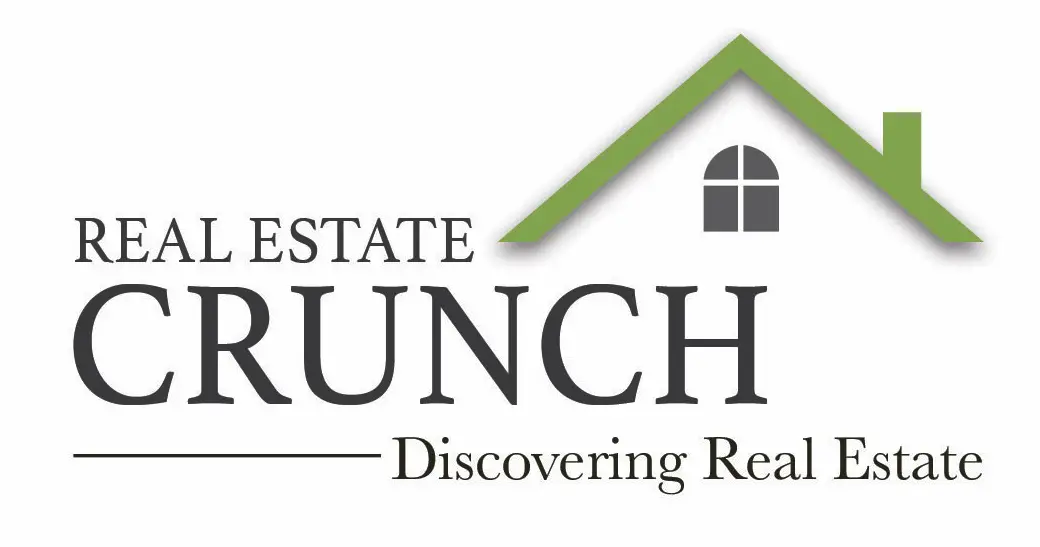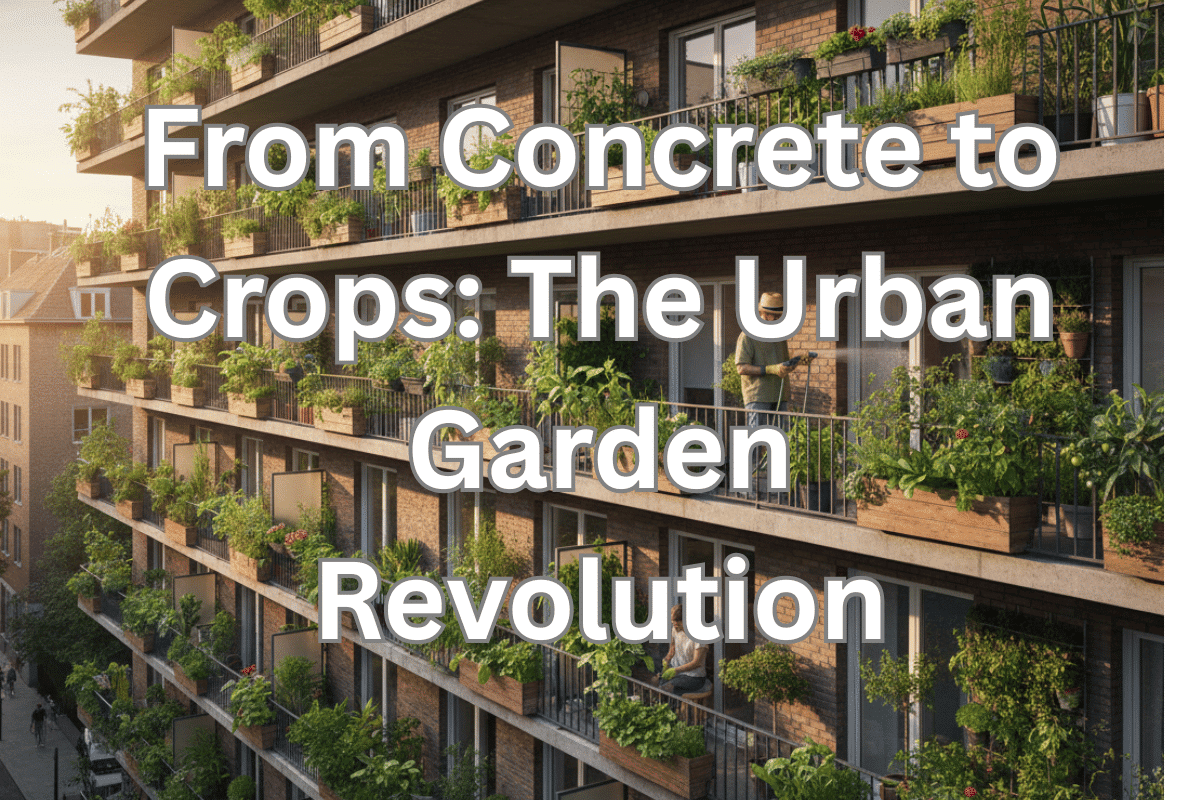What if you could save hundreds, even thousands, on your grocery bill every year, all while living in the heart of a bustling city? Imagine stepping just a few feet outside your door—or onto your rooftop—and harvesting fresh, organic produce without ever visiting a supermarket. Urban farming is transforming city living, and it’s not just about saving money; it’s about creating a sustainable, healthy, and fulfilling lifestyle.
As urban gardeners ourselves in Hanoi, Vietnam, we’ve experienced firsthand the joy and practicality of growing our own vegetables and herbs on our rooftop. From fragrant basil to crunchy lettuce, our little rooftop oasis not only saves us money but also connects us to nature in the middle of the city. In this post, we’ll explore how you, too, can turn your concrete jungle into a thriving, money-saving food paradise.
Table of Contents
- Why Urban Farming Matters: The Shocking Reality of Grocery Bills
- The Wallet-Friendly Harvest: Real Savings, Real Food
- Beyond the Balcony: Creative Urban Grow Spaces
- Getting Started: Your First Urban Farm in 3 Simple Steps
- Grow Your Future: Sustainability, Community & Next Steps
- From Concrete to Crops
- Deep Dive Podcast
- Related Question
Why Urban Farming Matters: The Shocking Reality of Grocery Bills
Let’s start with the reality check: food prices are soaring. Global grocery bills continue to hit unprecedented highs due to inflation, supply chain disruptions, and climate-related crop failures. According to recent statistics, the average household is spending 20–30% more on groceries compared to just five years ago.
For city dwellers, this is particularly challenging. Fresh produce, especially organic options, can feel like a luxury item. Wilted greens, overpriced herbs, and imported fruits are the norm in urban supermarkets. But what if you could bypass all of that?
Urban farming offers a solution: fresh, organic produce grown right at home. No more overpriced, underwhelming supermarket greens. Whether you have a rooftop, balcony, or even just a sunny windowsill, you can start growing your own food and take control of your grocery bill.

The Wallet-Friendly Harvest: Real Savings, Real Food
How much can you actually save by growing your own food? Let’s break it down.
The Cost of Growing vs. Buying
- Store-bought herbs: A small bundle of basil or cilantro can cost $2–$4 and lasts barely a week. Growing your own herbs costs pennies per plant and provides a continuous harvest for months.
- Lettuce and leafy greens: A single head of organic lettuce might cost $3–$5. With a small hydroponic system, you can grow multiple heads of lettuce for the same price—and keep harvesting.
- Tomatoes: A pound of organic tomatoes can easily cost $4–$6. A single tomato plant, grown in a pot, can yield 10–15 pounds of fruit in a season.
Hydroponics vs. Store-Bought Produce
A small hydroponic system costs around $100–$150 upfront. It might sound like a lot, but when you consider that it can produce hundreds of dollars’ worth of fresh greens, herbs, and vegetables annually, the savings quickly add up.
High-Yield Plants for Maximum Savings
If you’re looking for the most bang for your buck, focus on quick-growing, high-yield plants like:
- Lettuce: Ready to harvest in just 4–6 weeks.
- Spinach: A continuous harvest plant that grows quickly.
- Basil and mint: Perennial herbs that thrive with minimal care.
- Cherry tomatoes: Compact plants with high yields.
- Peppers: Easy to grow in containers and produce abundantly.
Beyond the Balcony: Creative Urban Grow Spaces
Urban farming isn’t limited to those with sprawling backyards. With a little creativity, you can grow food in even the tiniest spaces.
Vertical Gardening for Small Spaces
Vertical gardening is perfect for apartments and patios. By growing plants upward instead of outward, you can maximize your space. Consider:
- Wall-mounted planters.
- Hanging baskets for herbs and strawberries.
- Stackable pots for tiered gardening.
- DIY vertical gardens using wooden pallets or shelving units.
Repurposed Materials for DIY Planters
You don’t need to spend a fortune on fancy gardening equipment. Repurpose everyday items to create planters:
- Old containers, like buckets or jars, can become herb gardens.
- Wooden pallets make excellent vertical planters.
- Even bathtubs or old tires can be transformed into garden beds.
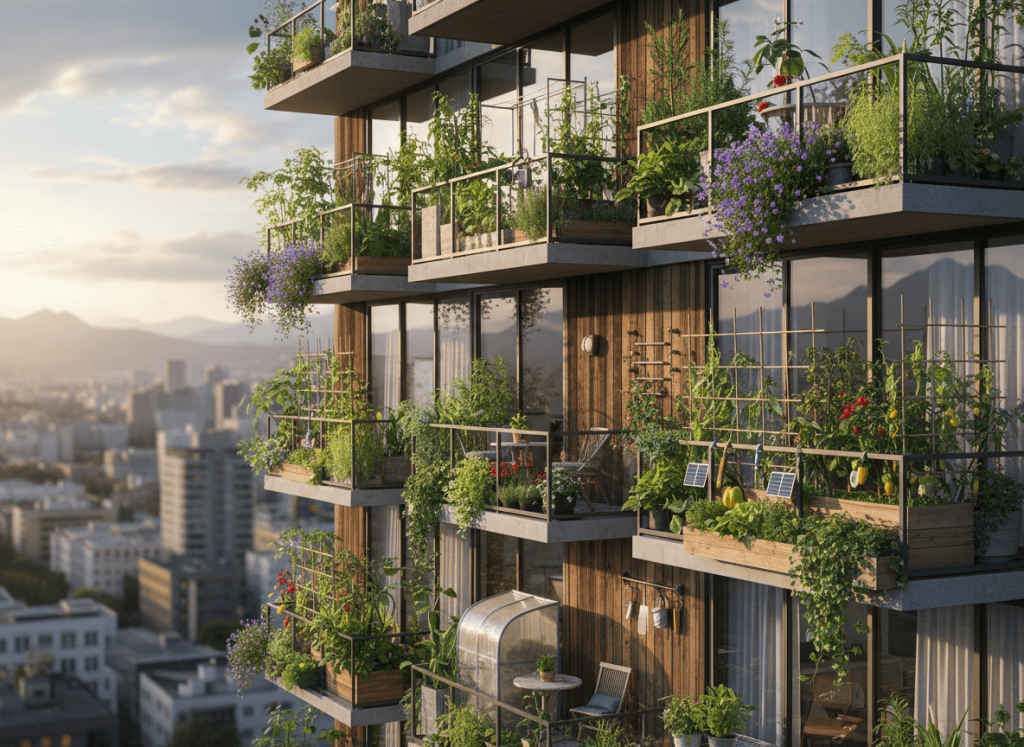
Community Gardens: Shared Spaces, Shared Resources
If you don’t have space at home, look for community garden initiatives in your city. These shared spaces offer access to garden plots, tools, and a supportive community of fellow growers. In Hanoi, for example, community gardens are popping up in unused urban spaces, bringing neighbors together to grow food and share harvests.
Getting Started: Your First Urban Farm in 3 Simple Steps
Starting your urban farm might seem intimidating, but it’s simpler than you think. Here’s how to get started:
1. Choose the Right Plants
Start with plants that match your available light and space. For example:
- Low-light spaces: Spinach, kale, and mint.
- Full sun spaces: Tomatoes, peppers, and basil.
- Small spaces: Microgreens and herbs.
2. Gather Essential Tools
You don’t need to invest in expensive gadgets. Start with these basics:
- Pots or containers with drainage holes.
- Quality soil or hydroponic growing medium.
- Seeds or starter plants.
- A watering can or spray bottle.
- Fertilizer (organic options are best for edible plants).
Budget-friendly beginner kits are also widely available and often include everything you need to get started.
3. Master Simple Watering and Feeding Tips
Consistency is key to a thriving urban garden. Here are some tips:
- Water your plants early in the morning to reduce evaporation.
- Use a moisture meter to avoid overwatering.
- Feed your plants with organic fertilizer every 2–4 weeks.
Even as beginners, you’ll be amazed at how quickly your garden starts to flourish with just a little attention.
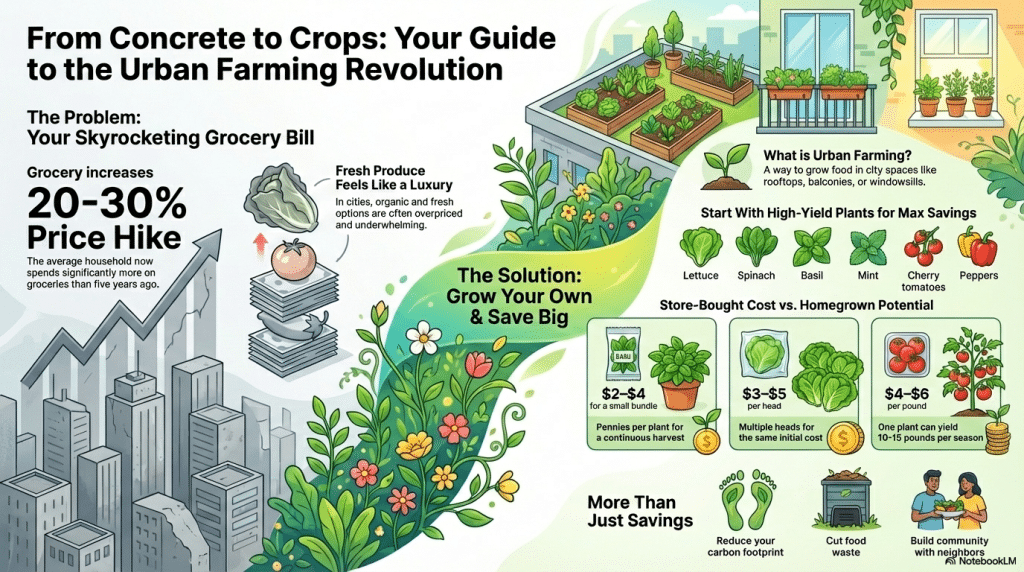
Grow Your Future: Sustainability, Community & Next Steps
Urban farming isn’t just about saving money—it’s about creating a more sustainable and connected way of life.
The Environmental Impact of Urban Farming
By growing your own food, you can:
- Reduce your carbon footprint by eliminating the need for long-distance food transportation.
- Cut down on food waste by harvesting only what you need.
- Support biodiversity by creating habitats for pollinators like bees and butterflies.
Building Community Through Urban Farming
Urban farming fosters connections with neighbors and local communities. Share your harvests, exchange tips, and collaborate on larger projects like community composting or seed swaps. In Hanoi, we’ve found that our rooftop garden has sparked conversations with neighbors and inspired others to start growing their own food.
Scaling Up Your Urban Farm
Once you’ve mastered the basics, consider scaling up your operation:
- Invest in a larger hydroponic or aquaponic system for higher yields.
- Experiment with new crops, like berries or root vegetables.
- Expand your garden to include composting or rainwater harvesting systems.
Tech Tools to Enhance Your Urban Garden
Take advantage of modern technology to make urban farming even easier:
- Smart garden apps: Monitor soil moisture, light levels, and plant health from your phone.
- AI farming tech: Use AI-powered tools to optimize your garden’s performance.
- Automated watering systems: Save time and ensure consistent care for your plants.
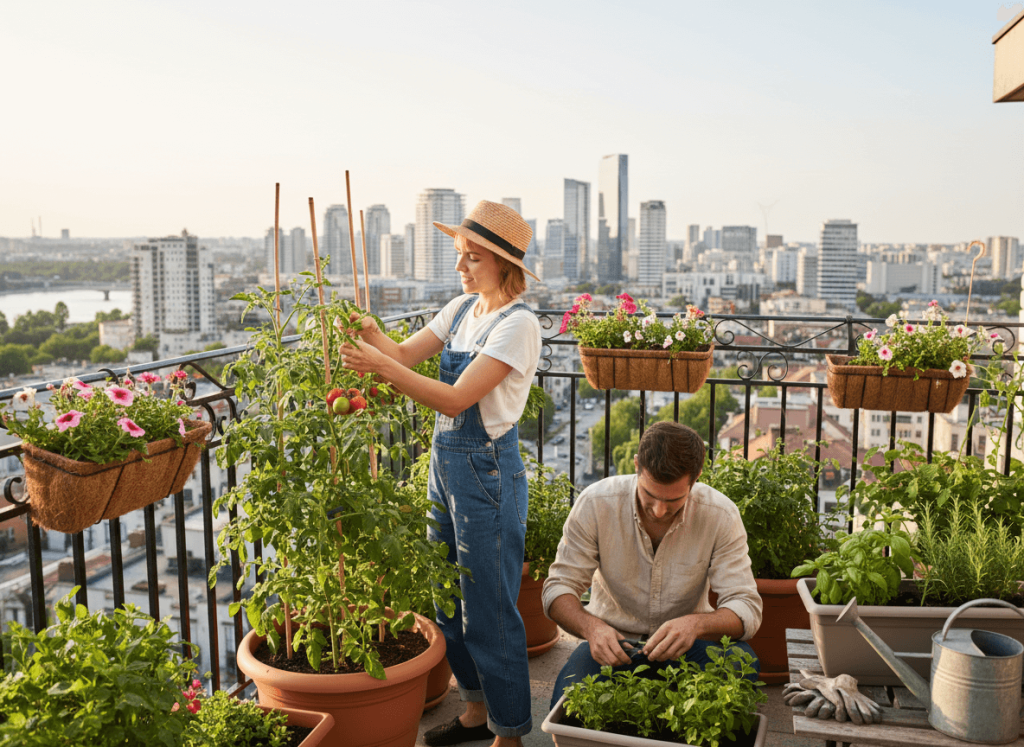
From Concrete to Crops
Urban farming is more than a trend—it’s a revolution in how we think about food, money, and sustainability. By turning your apartment, rooftop, or balcony into a productive garden, you can save money, eat healthier, and contribute to a greener planet.
As urban gardeners in Hanoi, we’ve seen the incredible benefits of growing our own vegetables and herbs. It’s not just about the savings; it’s about the joy of harvesting fresh, organic produce and knowing exactly where your food comes from.
So why not give it a try? Start small, grow what you love, and watch as your concrete jungle transforms into a thriving, money-saving food paradise. The urban garden revolution is here—are you ready to join?
Deep Dive Podcast
Check out our Deep Dive Podcast on Urban Gardening.
Real Estate Crunch gives you real property and real estate information and advice. We offer a free monthly newsletter; you can sign up for our newsletter by clicking here.
We also have a weekly podcast called “Real Estate Crunch,” found on all major podcast platforms. Listen to our podcast by clicking here.
Follow us on our social media platforms – Facebook and Instagram.
Related Question
Do Modular Homes Come With Electrical And Plumbing?
When you purchase a modular home, all the electrical and plumbing should be included in the cost of the house. The modular home will need to be up to the NEC code or standards for electrical. You must understand the quality and types of pipes and other fittings in the modular home and the manufacturer’s plumbing quality. We recommend that anyone looking to purchase a modular home check out the quality of the pipes and other fittings that the modular home manufacturer is using.
By clicking here, you can read more about Do Modular Homes Come With Electrical And Plumbing?
Do Modular Homes Come With HVAC?
When people look at investing in a modular home, they want to understand what comes with a modular home. In particular, if the house comes with HVAC units.
The modular home you purchase comes with some HVAC or heating and cooling system. What type of system will depend upon the type of mobile home you purchase and the type of technology and energy efficiency the modular home manufacturer uses.
By clicking here, you can read more about Do Modular Homes Come With HVAC?
Prefabricated Housing Trends
As affordable housing continues to be a massive problem in the United States and worldwide, we predict that prefabricated housing will become more critical in the years to come.
Prefabricated housing is a house that is made offsite and then brought to the site for final assembly. Many consider prefabricated housing to offer advantages that onsite housing does not have.
By clicking here, you can read more about Prefabricated Housing Trends.
